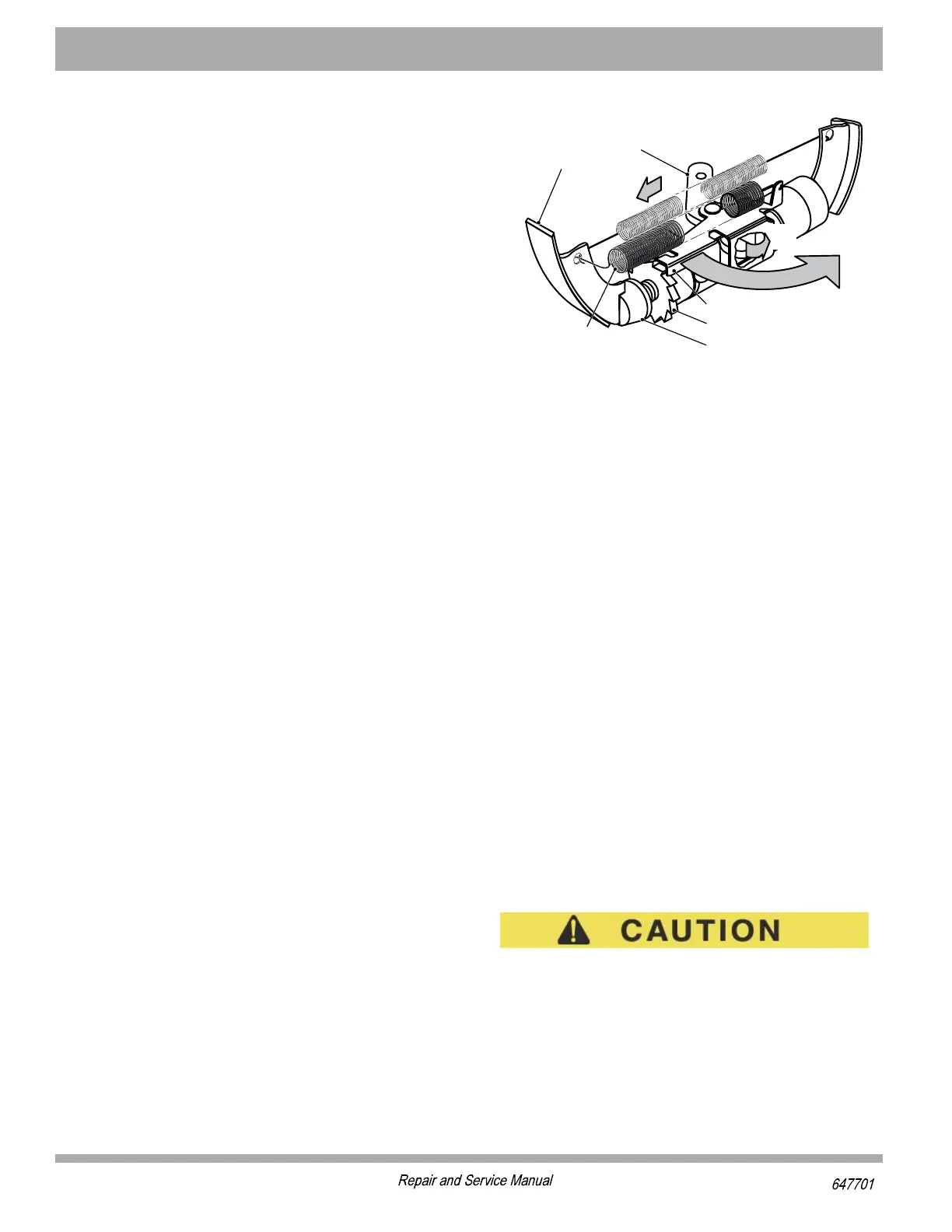96
BRAKES
Read all of SAFETY and this section before attempting any procedure. Pay particular attention to Notices, Cautions, Warnings and Dangers.
BRAKE SYSTEM OVERVIEW
General Description
This vehicle has a mechanically activated rear drum
brake system. The brake system has a service brake and
parking brake pedal, parking brake release linkage,
equalizer link, brake cables and wheel brake assemblies
which adjusts automatically (Figure 1).
Although the brake system is same as an automobile, it is
different in important ways. The system operates in a
very severe environment. The Fertilizer, dust, grass clip-
pings, tree roots and other objects can cause corrosion
and damage to the brake components. Different from
automotive hydraulic brakes, mechanical brakes depend
on the travel of the brake cables to move the brake shoes
against the brake drums. The travel of the brake cables is
governed by the brake pedal. If the cables can not travel
far enough to absorb the tension (free travel) in the sys-
tem and still apply the shoes to the drums, the braking
effort at the wheel brake will not be enough. The self
adjusting mechanism in the wheel brakes needs enough
cable travel at the wheel brake to work reliably. When the
brake is released, there must be slack in the system so
the brakes will release completely and the adjusters will
function. Free pedal travel, pedal force, shoe to drum
clearance and sudden stop ability are closely related. It is
very important to keep the correct connections to make
sure braking performance and the best wheel brake
adjustment.
How the Service Brake Works
When you release the service brake pedal, the equalizer
link is pulled, which is connected to the brake cables (Fig-
ure 1). The first part of the pedal travel removes tension
from the system. Continued motion of the brake pedal
pulls both the left and right brake cables. Each brake
cable pulls a brake lever which pushes the rear brake
shoe against the brake drum. When the rear shoe con-
tacts the brake drum, it can no longer move rearward.
Additional pedal (and cable) travel causes the actuator
bracket (moving anchor) to move and applies force to the
front shoe, pushing it against the brake drum. The force
applied to the front and rear shoes is approximately
equal. When the shoes contact the brake drum, the shoes
try to move in the direction of drum rotation. This move-
ment cause in the normal brake shoe wear patterns.
Equalizer Link
The equalizer link balances braking between the driver
and passenger sides of the vehicle. Variations in wheel
brake adjustment, cable friction and manufacturing toler-
ances may cause the equalizer to be slightly misaligned.
This misalignment is normal.
Figure 2 Wheel Brake Adjustment
Brakes adjust only while the vehicle is moving.
When you press the brake pedal, the brake lever moves
toward the front of the vehicle (A).
The other end of the brake lever moves to the rear of the
vehicle (B) where it contacts the brake adjuster arm,
causing it to move.
The brake adjuster arm moves away from the star wheel
(C). The amount of adjuster travel is limited by the
amount of brake shoe travel required to contact the brake
drum. The amount of travel increases as the brake shoe
lining wears.
When the brake pedal is released, the adjuster spring
retracts the brake adjuster arm which contacts the star
wheel. Note that adjustment only takes place when the
brake pedal is released while the vehicle is in motion.
If the brake shoes have worn far enough to permit the
brake adjuster arm to contact the next tooth of the star
wheel, the star wheel will be advanced by the tension
applied to the adjuster arm by the adjuster spring.
If the brake shoes have not worn enough to permit the
brake adjuster arm to contact the next tooth of the star
wheel, the brake adjuster arm will move on the flat of the
star wheel. The star wheel does not rotate and no adjust-
ment occurs.
Automatic Adjuster Mechanism
Never manually adjust the brakes at the star wheel.
Doing so will cause permanent damage to the
adjuster assembly and result in a gradual loss of
brakes.
The wheel brakes are equipped with an automatic
adjuster mechanism that is designed to compensate for
brake shoe wear and eliminate the need for manual brake
shoe adjustment. Do not manually adjust the brakes by
%
'
&VEOI0IZIV
&VEOI%HNYWXIV%VQ
7XEV;LIIP
%HNYWXMRK7GVI[
%HNYWXIV7TVMRK
&VEOI7LSI
&

